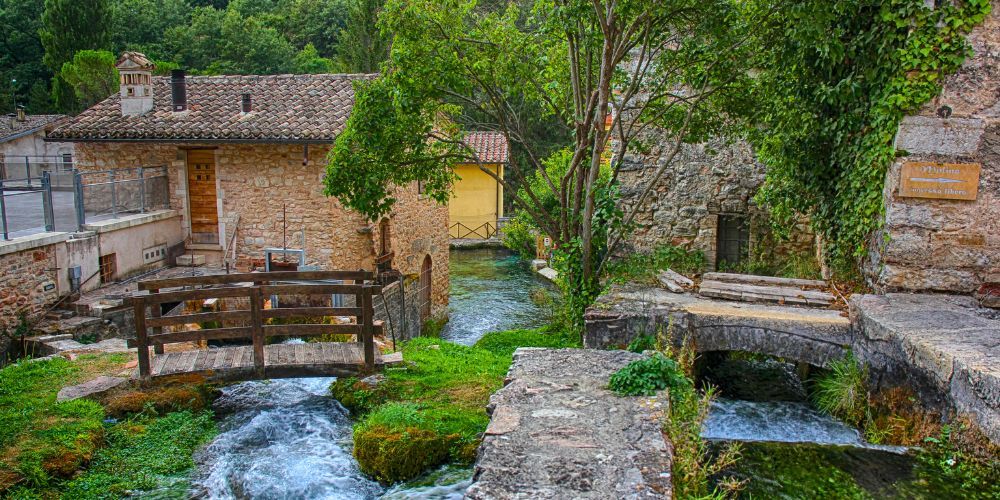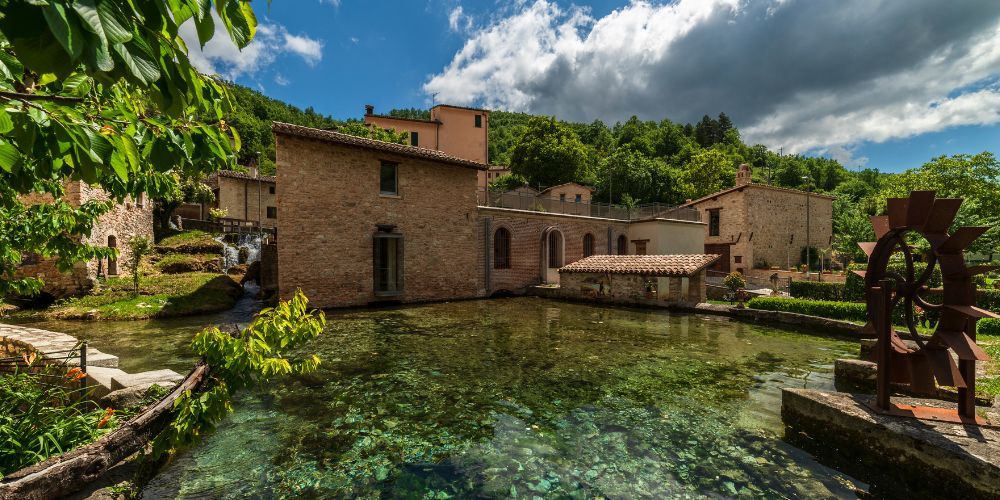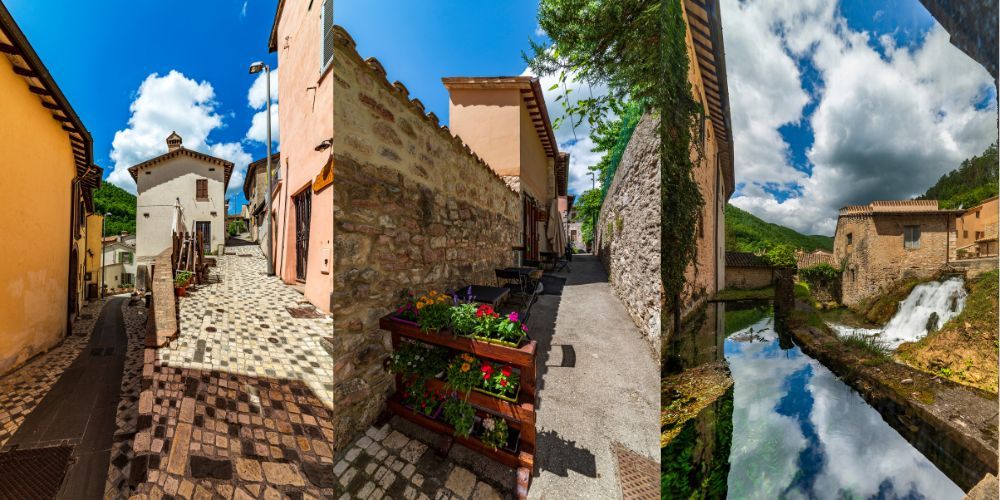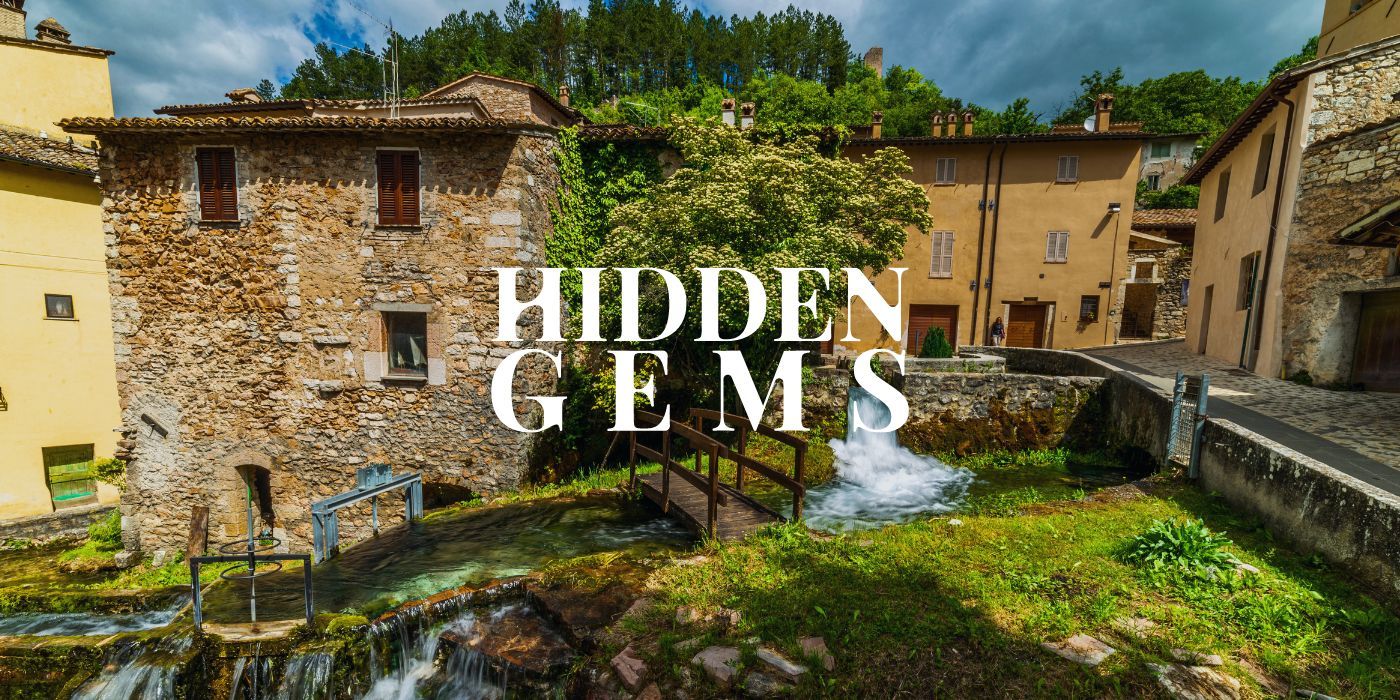Hidden in the green hills of Umbria, you will find a small medieval village that will fascinate you for its uniqueness: Rasiglia.
Walking through its narrow streets interspersed with small wooden bridges, you will be surprised by the abundant presence of water. Streams flowing between the little stone houses, intertwining streams, pools and small waterfalls scattered here and there.
Water is the main element that makes Rasiglia one of the most characteristic villages in Umbria. This is why it has earned the title of little Venice of Umbria.
The village stands on a hill over 600 metres above sea level, in the province of Foligno, near Assisi and Perugia. And it is an ideal stop for an an off-road trip in Umbria, where one can lose oneself in an enchanted and timeless place.
Rasiglia is a village of mysterious charm with a thousand secrets to unveil. Besides admiring its picturesque views, you can retrace the traces of its history and learn about its ancient crafts.
Are you curious to discover more about this hidden gem? Then read on below about what to see and do in Rasiglia!

Rasiglia: what to see in this village with a thousand-year history

Rasiglia is a village founded around the 12th or 13th century, one of the most beautiful in Umbria. It was a town of great commercial importance thanks, above all, to Via della Spina, the historic road that runs through it and that once connected the Tyrrhenian and Adriatic coasts.
However, the town reached a period of maximum splendour with the development of numerous craft activities, due to the abundant presence of water in the town. For this reason, Rasiglia became an ideal place for the construction of mills, factories and woollen mills. In particular, it is remembered for the manufacture of textiles.
The village also saw the transition to the modern industrial system, with the construction of a hydroelectric power station and the use of more advanced machinery for textile production.
But its period of splendour was followed by a period of decline. In fact, after World War II, the factories were moved to Foligno and slowly the town began to depopulate. The situation worsened with the earthquake of 1997. To date, Rasiglia has only 40 inhabitants.
Listen to the podcast version of the article with Monna Lisa and Leonardo's voices
Rasiglia: what to see in the magical village on the water in Umbria

In Rasiglia you will find water everywhere, it will really feel like the village is floating on water. Everywhere you turn there are streams, torrents, pools of water, small dams and waterfalls that create a truly unique and idyllic scenery.
The crystal-clear water in the village comes from the Capovena Spring, located in the upper part of the village. As it descends, the water branches out like a spider's web throughout the village, forming veritable water mazes, which in turn flow into the Menotre River.
Of the numerous water basins in the village, the largest and most impressive is the Peschiera, once used for washing sheep before shearing. An unmissable stop that certainly won't go unnoticed, where you can take beautiful photos under the shades of the water's colours.
As mentioned earlier, the entire village is criss-crossed by waterways. But these canals built in the past had a very specific purpose: to bring water to the mills, woolen mills, dye works and houses.
This way, the intention was to make full use of water power and to feed the village's craft activities, a true combination of brilliance and beauty that make Rasiglia one of the most picturesque and unique villages in Italy.
Strolling around the alleys in Rasiglia: let’s discover ancient crafts

Getting lost in the alleyways of Rasiglia is a must, a way to retrace its past and discover the village's ancient crafts. There are several mills in the village.
The most important is the Stone Mill, once used for the production and milling of flour and wheat. For the more curious, you can visit its interior where you will find preserved objects used for grinding.
Near the mill, you can also visit the former Accorimboni Wool Mill, now used as a venue for exhibitions and events. From inside you can look out over the water basin, the Peschiera.
Another attraction not to be missed is the Lavatoio which will really take you back in time discovering this place symbol of Rasiglia's bond with water. Although it has been restored, it is in excellent condition and you can still see how it was used in the past.
In addition, in the old town centre you can visit some premises that have on display ancient objects and tools used for weaving and dyeing wool.
Among them you will find an old mechanical loom dating back to the 19th century, still in good condition, a true direct testimony of the predominant craft activities in the village, which will make your experience even more authentic and timeless.
How to get to Rasiglia

The village of Rasiglia is located in the eastern part of Umbria, not far from the border with Le Marche, in a geographical position that has always been a historical crossroads between the regions of central Italy.
Although Rasiglia can only be reached by road, the village on the water is well connected to the main cities of the territory thanks to the presence of important roads that cover a vast inter-regional area, for example SS3 that starts from Rome touching places like Spoleto and Foligno and SS77 Val di Chienti towards Le Marche.
These routes are perfect for traveling by car or bus; alternatively, provincial roads such as SP401 and SP408 allow you to follow a travel itinerary also suitable for those who wish to travel by bike, in particular starting from Perugia, one of the best ways for a sustainable tourism experience in one of the greenest regions in Europe!
Book now your visit to Duomo of SpoletoOther interesting places to visit next to Rasiglia
The village on the water is also home to other interesting places to visit. For example, at the top of the hill is Rasiglia Trinci Castle, built around 1250 by the lords of Foligno.
It was built to keep the entire valley under control and to counter the expansionist aims of Spoleto. Today, there are only the ruins of the castle, but the walk up to the top is pleasant and offers a beautiful view of the village and the valley.
Another place of interest is the Ancient Sanctuary of the Madonna delle Grazie, erected in 1450 on the site where a statue of the Virgin was found. We recommend you visit the interior where you will be fascinated by the marvellous frescoes in gold, red and green.
If you're looking for more unmissable places to visit in Umbria, especially if you love excellent wine, please check out the button below!
Book now your guided visit with wine tasting in MontefalcoThe unmissable events in Rasiglia on your trip to Umbria
Penelope a Rasiglia is an event organised in Rasiglia every June, in honour of textile processing.
During this festival, you can attend workshops on the entire weaving process, from shearing sheep to dyeing wool. A not-to-be-missed event that will give you the chance to spend two days enjoying poetry, theatre, music and art.
If you are interested in visiting the village in winter, we recommend a visit to the living Nativity di Rasiglia in which the inhabitants of the village will welcome you dressed in the clothes of their trade: carpenters, washerwomen, blacksmiths, shoemakers, dyers, etc.
In addition, in each dwelling are represented the village's ancient craft activities.
On those days, the whole village takes on a magical and intimate atmosphere, under the dimmed lights of the candles and the smells of old times, an exciting experience in one of the most evocative Italian Christmas villages. A unique event where you can really breath in the air of the past and identify with the ancestors of Rasiglia.
About the author
Written on 29/08/2024



Marika Lagarese
Do you know that in Umbria there’s a medieval village on the water? Its name is Rasiglia, a truly and one of a kind place: let’s find out what to see!